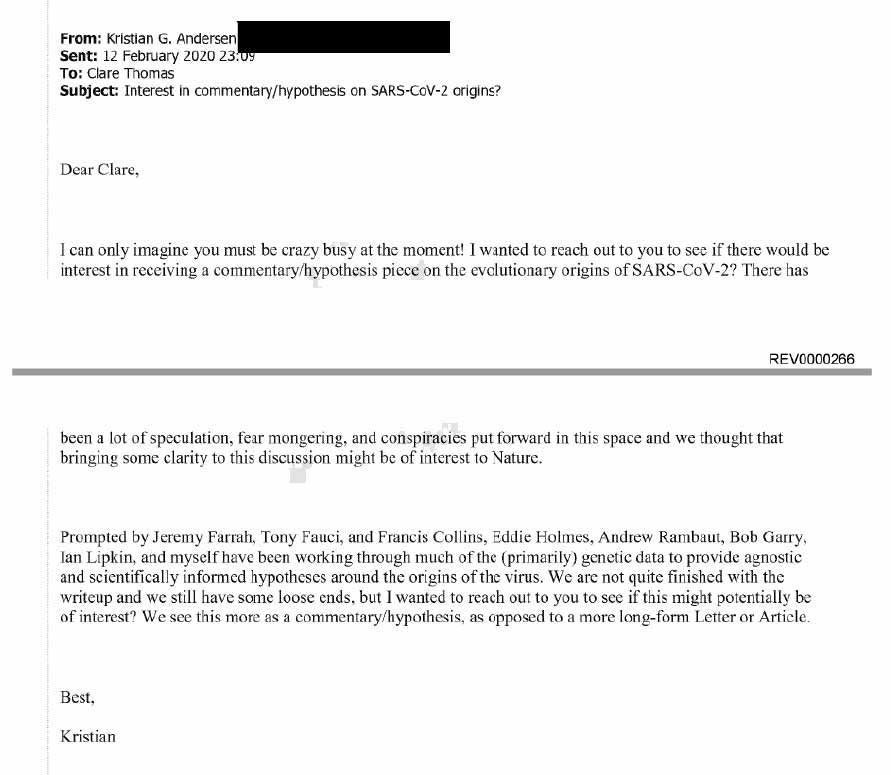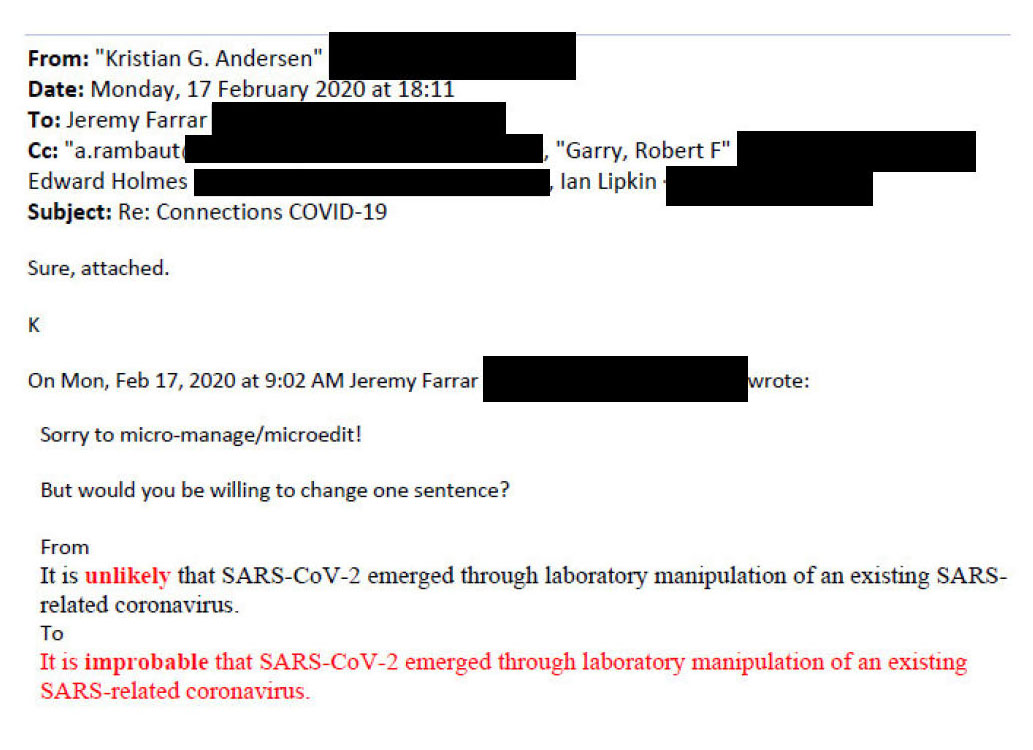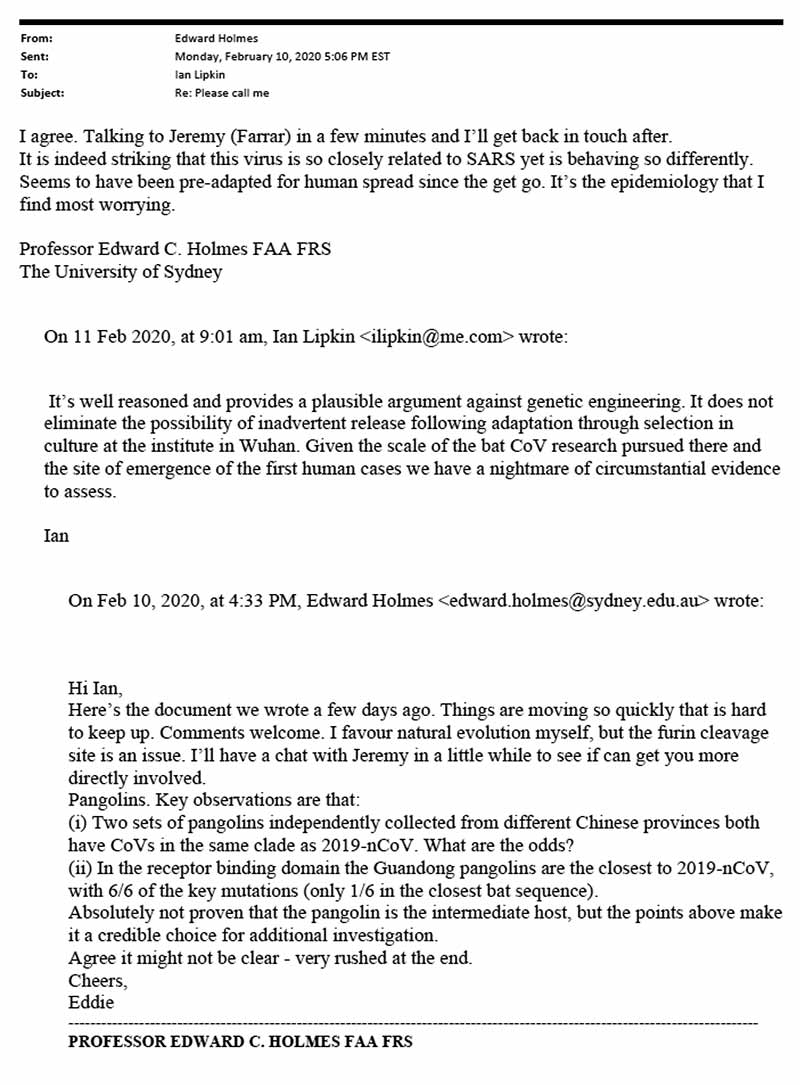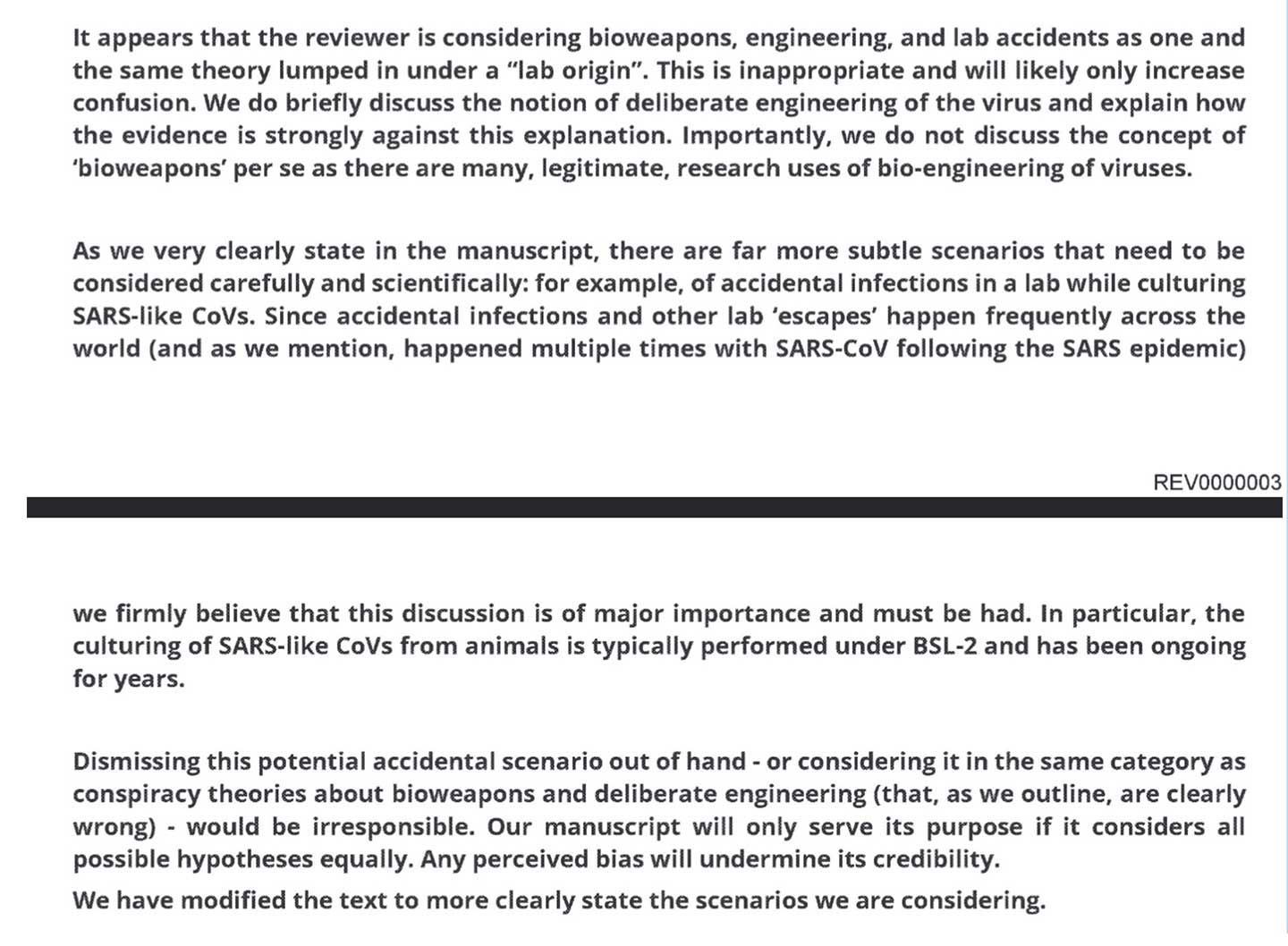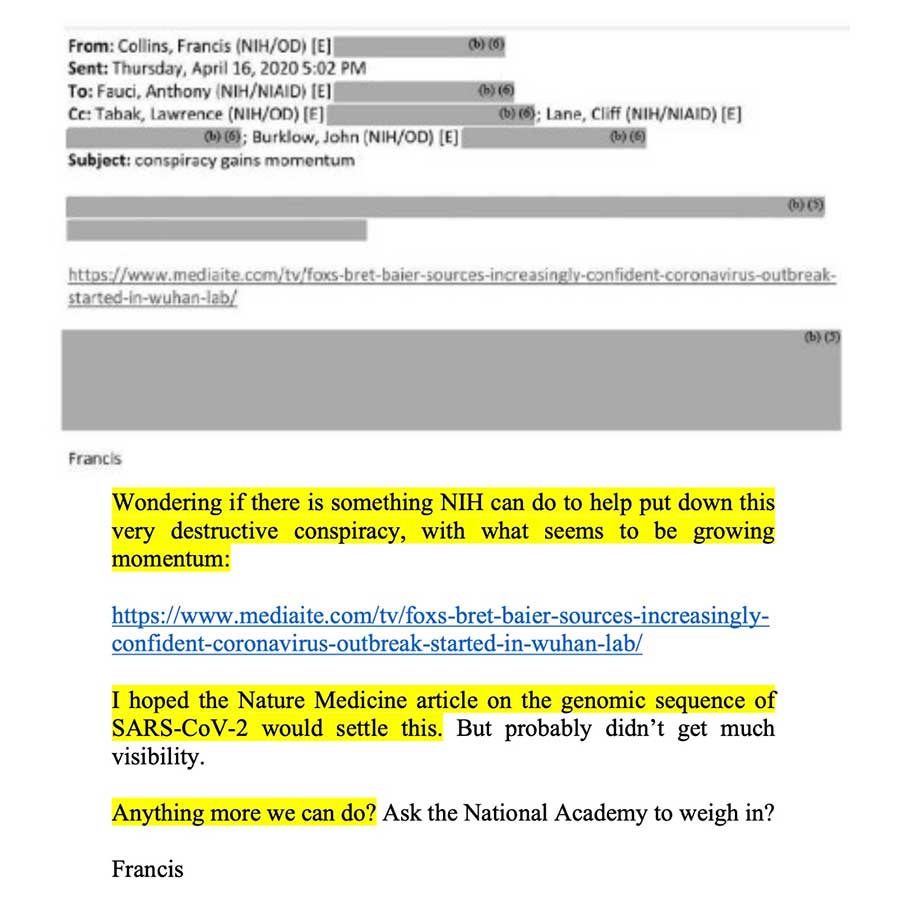The House Select Subcommittee on the Coronavirus Pandemic has released to The Nation a set of documents that shed light on the production and publication of a controversial scientific paper that helped shape the early public debate about the origin of Covid-19. The documents, which were the basis of a memo the subcommittee released in early March as part of its investigation into the pandemic’s origin, have not previously been available to the public in full standalone form. Among other things, the documents highlight the involvement of several top health officials, including Dr. Anthony Fauci, in prompting the work that led to the paper, titled “The Proximal Origin of SARS-CoV-2.” They also offer an inside glimpse into the peer-review process that preceded the influential paper’s publication.
“The Proximal Origin of SARS-CoV-2,” commonly known as the Proximal Origin paper, was published in the journal Nature Medicine in mid-March 2020. Though its authors did not entirely dismiss the possibility of a laboratory origin for the virus, they firmly favored a natural origin, writing that “we do not believe that any type of laboratory-based scenario is plausible.” The paper, written by five prominent scientists, would ultimately be cited by thousands of media outlets and accessed online more than 5 million times. Dr. Francis Collins, then the director of the NIH, wrote about it on his agency’s website in March 2020, and Fauci spoke about it during a White House press briefing in April 2020.
Largely unknown at the time of its publication, however, was the fact that the paper grew out of a series of confidential discussions between its authors, other scientists, and top leaders at the NIH, specifically Collins and Fauci. Those confidential conversations kicked off in earnest with a February 1, 2020 teleconference, after several top virologists alerted Fauci to their concerns that the virus looked potentially engineered. What ensued was more than a week of close-to-the-chest deliberation between the scientists and health officials in which they wrestled with the possibility that SARS-CoV-2 emerged via a lab. During the course of these discussions, early drafts of the Proximal Origin paper—which were more neutral on the question of the virus’s origin than the final published version—were circulated among the group. The Nation and The Intercept copublished an in-depth look at those confidential 2020 discussions earlier this year, which you can read here.
The Proximal Origin paper’s production, publication, and influence remain the subject of heated controversy in the debate about Covid’s origin, a debate that became particularly politicized after President Trump claimed publicly in late April 2020 that his administration had evidence that Covid-19 came from a Chinese lab. Some have said that the paper’s ultimate conclusions reflect nothing more or less than the scientific process at work. “I’ve absolutely no problem with people knowing that my views on this issue have evolved as more data have appeared. That’s science,” wrote one of the paper’s authors, Eddie Holmes of the University of Sydney, in an e-mail obtained via FOIA. “Indeed, I’ve told this to many people: the way see [sic] it is that we set-up an hypothesis and then tested it. As far I [sic] can tell we are only ‘guilty’ of following the proper scientific method.”
Popular
"swipe left below to view more authors"Swipe →
Others, including former CDC director Robert Redfield, a virologist, see things differently.
“I think it is an inaccurate paper that basically was part of a narrative that they were creating,” he testified at the House coronavirus subcommittee’s first hearing on the origin of Covid-19, which was held early last month. “This was a narrative,” he added, “that was decided that they were going to say this came from the wet market and they were going to do everything they could to support it to negate any discussion about the possibility that this came from a laboratory.” Redfield’s reference to “wet market” here refers to the theory that SARS-CoV-2 jumped into humans at a market that sold live animals in Wuhan.
The documents released by the select Covid subcommittee offer details about how the paper found its way to publication.
They show that on February 12, 2020, Dr. Kristian Andersen, a professor at Scripps Research and a key author of the Proximal Origin paper, sent an e-mail to an editor at the journal Nature to gauge her interest in publishing the paper. He noted in the e-mail that he and his co-authors had been “prompted” in their efforts by Fauci, Collins, and Jeremy Farrar, then the leader of a major UK research institution called the Wellcome Trust and a key organizer of the February 1 teleconference between the NIH officials and top scientists.
Just four days before Andersen e-mailed Nature, however, he had told his collaborators that he was against publishing a paper at the time.
“Our main work over the last couple weeks as been focused on trying to disprove any type of lab theory, but we are at a crossroad where the scientific evidence isn’t conclusive enough to say whether we have high confidence in any of the three main theories considered,” he wrote to several colleagues, according to unredacted e-mails obtained in a FOIA lawsuit by this reporter.
“As to publishing this document in a journal,” he added, “I am currently not in favor of doing so. I believe that publishing something that is open-ended could backfire at this stage.”
It is unclear from the documents what transpired over the next few days that changed his mind, and Andersen did not respond to a request for comment. But at least one of the orchestrators of the confidential discussions in early February 2020, Jeremy Farrar, seemed eager to get something out into the public domain. In an e-mail on February 8, Farrar wrote to several of the participating scientists and shared his own views on publishing what would become the Proximal Origin paper.
“The theory of the origin of the [sic] has gathered considerable momentum not in social media, but increasingly among some scientists, in main stream media, and among politicians.”
“My preference is that a carefully considered piece of science, early in the public domain, will help mitigate more polarised debate. If not, that debate will increasingly happen and science will be reacting to it. Not a good position to be in.”
Farrar would remain closely involved with the paper as it moved toward publication.
“Thanks for shepherding this paper,” wrote W. Ian Lipkin, one of Proximal Origin’s authors, in a February 17 e-mail to Farrar that was obtained by the House subcommittee. “Rumors of bioweaponeering are now circulating in China.”
“Yes I know and in US—why so keen to get out ASAP,” Farrar responded. “I will push Nature.”
Farrar, who was recently named the chief scientist at the World Health Organization, also appears to have helped edit the Proximal Origin paper before it was published.
Despite his involvement with the paper’s production, Farrar was not listed as an author on the Proximal Origin paper. He was, however, a signatory on a letter published on February 19, 2020, in The Lancet in which a group of prominent scientists wrote, “We stand together to strongly condemn conspiracy theories suggesting that Covid-19 does not have a natural origin.”
The subcommittee’s documents, some of which were previously obtained by Vanity Fair, also show the Proximal Origin authors grappling with features and characteristics of the virus that raised questions about its provenance. These concerning characteristics include the furin cleavage site—a feature of SARS-CoV-2 that plays an important role in helping it infect human airway cells and which has not been found in other SARS-related coronaviruses.
According to the select subcommittee, the documents also contain the Proximal Origin authors’ response to a series of questions from peer reviewers prior to publication.
“Another critical aspect of this text is the complete lack of referencing to a potential debate on a hypothetical lab origin,” wrote one peer reviewer. “Who said this, why is this considered a problem? There are indeed a few apparently uninformed statements claiming the virus may be a Chinese bioweapon, but is this really problematic on a larger scale? The central reason for issuing this text must be exhaustively referenced and discussed.”
The Proximal Origin authors responded, in part, as follows:
In response to a separate peer-reviewer, they also explained their general thinking about the possibility of a lab leak:
Unlike numerous earlier drafts, the Proximal Origin paper in its final form would come down firmly in favor of a natural origin for SARS-CoV-2, with its authors stating that “we do not believe that any type of laboratory-based scenario is plausible.” Its findings, however, did not put to rest discussions circulating in the public domain in the spring of 2020 about the possible lab origin of SARS-CoV-2. This concerned top officials at NIH.
According to redacted e-mails obtained, transcribed and released by Republicans on the House Oversight and Reform Committee last year, Francis Collins wrote the following to Fauci and other NIH staff the month after the Proximal Origin paper was published:
Fauci responded on April 17, saying, “I would not do anything about this right now. It is a shiny object that will go away in times [sic].” However, it was later that very day, April 17, when Fauci referenced the Proximal Origin paper from the White House podium.
You can find the full set of House documents released to The Nation here.
Amid questions about his own involvement with the Proximal Origin paper, Fauci reportedly told a writer for the New York Times opinion section in late March this year that “he’s not sure he ever got around to reading the paper.”
Documents, as well as Fauci’s April 2020 statement from the White House podium, seem to indicate otherwise. According to e-mails obtained via FOIA, Kristian Andersen on March 6, 2020, wrote to Farrar, Fauci, Collins, and others to tell them the paper had been accepted for publication. “Thank you for your advice and leadership as we have been working through the SARS-CoV-2 ‘origins’ paper,” he wrote. “We’re happy to say that the paper was just accepted by Nature Medicine and should be published shortly (not quite sure when).”
Fauci’s response: “Thanks for your note. Nice job on the paper.”
Given the context that surrounded its production, publication, and promotion, the Proximal Origin paper is sure to figure into forthcoming House hearings on the origin of Covid-19, according to a Republican select subcommittee aide. The subcommittee’s next hearing, on April 18, will “examine China’s role in the origins of Covid-19 and the intelligence surrounding where Covid-19 originated.”
The Proximal Origin authors either declined to comment or did not respond to requests for comment that were e-mailed directly to them or to the institutions where they work. Nor did the Wellcome Trust or the NIH respond to queries.

